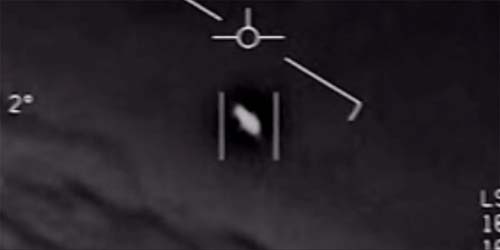
America’s rigorous report the right way to approach ‘UFOs’
Nidhal Guessoum
The Pentagon has released its eagerly awaited report on “unidentified aerial phenomena” (UAP), but with rather bland and unspectacular conclusions. It left UFO enthusiasts unhappy, if not fuming. Still, the report was a very interesting development. Let us review this.
First, why did the US Department of Defense need to release a report that relates, at least in most people’s minds, to UFOs? In the last few years, images, videos and testimonies from US Air Force pilots have emerged, showing intriguing visual “phenomena,” sometimes with strange motion. Furthermore, it turned out that the Pentagon had conducted a $22 million study of UFO events between 2007 and 2012, following earlier investigations, all justified by the possibility that foreign powers (the Soviet Union, then Russia, China and possibly others) may have developed threatening flying technologies. Thus, Congress ordered a report from the Office of the Director of National Intelligence.
Secondly, I must stress that the report does not even mention UFOs, but rather investigates UAP, which relate to the Air Force and intelligence matters. Moreover, the report is labeled “a preliminary assessment,” insisting that the data is insufficient to draw definitive conclusions on most cases, but stresses that “UAP clearly pose a safety of flight issue and may pose a challenge to US national security.”
The short report (six pages, plus two half-page appendices and a cover page) is rigorous and cautious. It acknowledges that some UAP images and videos may be due to glitches in the system, i.e., imperfect cameras, inaccurately calibrated sensors, slight tremors in the craft while it recorded the videos, etc. It also insists that cases of this kind — and many others that may come to light — will probably have a variety of explanations.
Indeed, the report proposed five categories of potential explanations for these UAP: “Airborne clutter” (drones, balloons, even birds); natural atmospheric phenomena (ice crystals and such); US government (possibly classified) or aerospace industry developmental programs; foreign adversary systems; and a general “other” category.
But the report also concludes that “most of the UAP reported probably do represent physical objects,” as 80 of the 144 cases that it documented were detected in multiple ways, including via “radar, infrared, electro-optical, weapon seekers, and visual observation.”
Skeptics applauded the report’s rational and scientific approach of trying to find plausible earthly explanations.
Finally, the report notes that UAP sightings have tended to “cluster around US training and testing grounds.” Furthermore, there were 18 incidents since 2004 where observers reported unusual movement patterns or flight characteristics: “Some UAP appeared to remain stationary in winds aloft, move against the wind, maneuver abruptly, or move at considerable speed, without discernible means of propulsion.” And in a few cases, military aircraft systems recorded radio waves associated with UAP.
However, the report hastens to stress that the data may be biased by the way that such UAP cases are observed and documented (by people, places and instruments) and that those “interesting” cases will be subjected to further analysis. In other words, UAP may or may not be just US Air Force events.
But is there no UFO possibility here (the public eagerly asks)? As mentioned above, the report does not refer to UFOs, and certainly not extraterrestrial or space alien possibilities. However, some officials close to the investigation have told US media outlets that UFOs and extraterrestrials have not been ruled out; it is just that the focus here was on the Air Force, military, intelligence, and technology aspects (“foreign threats”).
This did not stop UFO enthusiasts and skeptics from picking up where the report left off and commenting at length about what this may imply. UFO advocates were outraged by the report not interviewing witnesses and not even acknowledging that alien origins are a possibility, at least for some of the cases. UFO skeptics, however, applauded the report’s rational and scientific approach of trying to find plausible earthly explanations to those “aerial phenomena” and just saying “we don’t know” when the data was insufficient to draw a conclusion. Witnesses are notoriously unreliable because they are unfamiliar with various events and phenomena (rocket launches, satellite passes, weather balloons, optical reflections, and more), and their minds and memories play all kinds of tricks on them.
So what makes this short and rather inconclusive report “a very interesting development,” as I stated at the outset? It was a pleasant surprise to note the clarity and rigor of the report. We scientists have been saying for ages: Do collect data and evidence on these events and phenomena; do analyze everything with an open mind; ignore conspiracy ideas; exhaustively look for earthly explanations; and do not jump to extraterrestrial conclusions. It is extremely pleasing to see this approach reflected in the report.
This latest episode will not end the saga of UFO debates; far from it. Those who are firm in their views on the topic will not be swayed either way. But perhaps those who have not made up their minds will find this report useful as to how the topic should be approached. If we learn to examine problems properly, our future will be rosier.
The writer is a professor of physics and astronomy at the American University of Sharjah, UAE.
